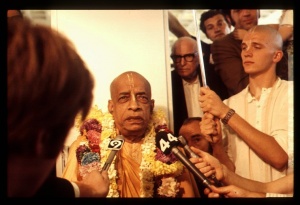CC Adi 17.83: Difference between revisions
m (1 revision(s)) |
(Vanibot #0054 edit - transform synonyms into clickable links, which search similar occurrences) |
||
| (One intermediate revision by one other user not shown) | |||
| Line 1: | Line 1: | ||
{{ | [[Category:Sri Caitanya-caritamrta - Adi-lila Chapter 17|C083]] | ||
<div style="float:left">'''[[Sri Caitanya-caritamrta|Śrī Caitanya-caritāmṛta]] - [[CC Adi|Ādi-līlā]] - [[CC Adi 17|Chapter 17: The Pastimes of Lord Caitanya Mahāprabhu in His Youth]]'''</div> | |||
<div style="float:right">[[File:Go-previous.png|link=CC Adi 17.82|Ādi-līlā 17.82]] '''[[CC Adi 17.82|Ādi-līlā 17.82]] - [[CC Adi 17.84|Ādi-līlā 17.84]]''' [[File:Go-next.png|link=CC Adi 17.84|Ādi-līlā 17.84]]</div> | |||
{{CompareVersions|CC|Adi 17.83|CC 1975|CC 1996}} | |||
{{RandomImage}} | |||
==== TEXT 83 ==== | ==== TEXT 83 ==== | ||
<div | <div class="verse"> | ||
rakta-pīta-varṇa,—nāhi aṣṭhi-valkala | :rakta-pīta-varṇa,—nāhi aṣṭhi-valkala | ||
eka janera peṭa bhare khāile eka phala | :eka janera peṭa bhare khāile eka phala | ||
</div> | </div> | ||
| Line 12: | Line 16: | ||
==== SYNONYMS ==== | ==== SYNONYMS ==== | ||
<div | <div class="synonyms"> | ||
rakta-pīta- | ''[//vanipedia.org/wiki/Special:VaniSearch?s=rakta&tab=syno_o&ds=1 rakta]-[//vanipedia.org/wiki/Special:VaniSearch?s=pīta&tab=syno_o&ds=1 pīta]-[//vanipedia.org/wiki/Special:VaniSearch?s=varṇa&tab=syno_o&ds=1 varṇa]'' — the mangoes were red and yellow in color; ''[//vanipedia.org/wiki/Special:VaniSearch?s=nāhi&tab=syno_o&ds=1 nāhi]'' — there was none; ''[//vanipedia.org/wiki/Special:VaniSearch?s=aṣṭhi&tab=syno_o&ds=1 aṣṭhi]'' — seed; ''[//vanipedia.org/wiki/Special:VaniSearch?s=valkala&tab=syno_o&ds=1 valkala]'' — or skin; ''[//vanipedia.org/wiki/Special:VaniSearch?s=eka&tab=syno_o&ds=1 eka]'' — one; ''[//vanipedia.org/wiki/Special:VaniSearch?s=janera&tab=syno_o&ds=1 janera]'' — man’s; ''[//vanipedia.org/wiki/Special:VaniSearch?s=peṭa&tab=syno_o&ds=1 peṭa]'' — belly; ''[//vanipedia.org/wiki/Special:VaniSearch?s=bhare&tab=syno_o&ds=1 bhare]'' — filled up; ''[//vanipedia.org/wiki/Special:VaniSearch?s=khāile&tab=syno_o&ds=1 khāile]'' — if he would eat; ''[//vanipedia.org/wiki/Special:VaniSearch?s=eka&tab=syno_o&ds=1 eka]'' — ''one; ''[//vanipedia.org/wiki/Special:VaniSearch?s=phala&tab=syno_o&ds=1 phala]'' — fruit. | ||
</div> | </div> | ||
| Line 19: | Line 23: | ||
==== TRANSLATION ==== | ==== TRANSLATION ==== | ||
<div | <div class="translation"> | ||
The fruits were all red and yellow, with no seed inside and no skin outside, and eating one fruit would immediately fill a man’s belly. | The fruits were all red and yellow, with no seed inside and no skin outside, and eating one fruit would immediately fill a man’s belly. | ||
</div> | </div> | ||
| Line 26: | Line 30: | ||
==== PURPORT ==== | ==== PURPORT ==== | ||
<div | <div class="purport"> | ||
In India a mango is considered best when it is red and yellow, its seed is very small, its skin is very thin, and it is so palatable that if a person eats one fruit he will be satisfied. The mango is considered the king of all fruits. | In India a mango is considered best when it is red and yellow, its seed is very small, its skin is very thin, and it is so palatable that if a person eats one fruit he will be satisfied. The mango is considered the king of all fruits. | ||
</div> | </div> | ||
__NOTOC__ | |||
<div style="float:right; clear:both;">[[File:Go-previous.png|link=CC Adi 17.82|Ādi-līlā 17.82]] '''[[CC Adi 17.82|Ādi-līlā 17.82]] - [[CC Adi 17.84|Ādi-līlā 17.84]]''' [[File:Go-next.png|link=CC Adi 17.84|Ādi-līlā 17.84]]</div> | |||
__NOTOC__ | |||
__NOEDITSECTION__ | |||
Latest revision as of 18:45, 19 February 2024
Śrī Caitanya-caritāmṛta - Ādi-līlā - Chapter 17: The Pastimes of Lord Caitanya Mahāprabhu in His Youth

His Divine Grace
A.C. Bhaktivedanta Swami Prabhupada
A.C. Bhaktivedanta Swami Prabhupada
TEXT 83
- rakta-pīta-varṇa,—nāhi aṣṭhi-valkala
- eka janera peṭa bhare khāile eka phala
SYNONYMS
rakta-pīta-varṇa — the mangoes were red and yellow in color; nāhi — there was none; aṣṭhi — seed; valkala — or skin; eka — one; janera — man’s; peṭa — belly; bhare — filled up; khāile — if he would eat; eka — one; phala — fruit.
TRANSLATION
The fruits were all red and yellow, with no seed inside and no skin outside, and eating one fruit would immediately fill a man’s belly.
PURPORT
In India a mango is considered best when it is red and yellow, its seed is very small, its skin is very thin, and it is so palatable that if a person eats one fruit he will be satisfied. The mango is considered the king of all fruits.